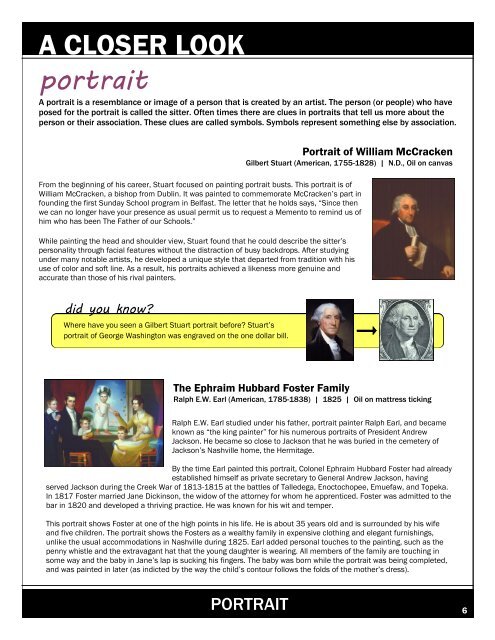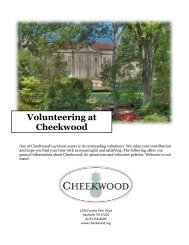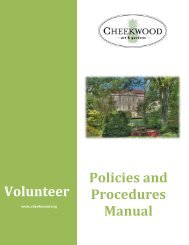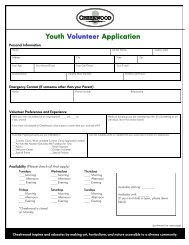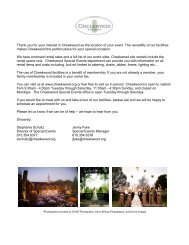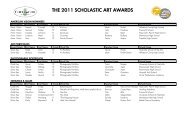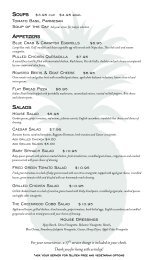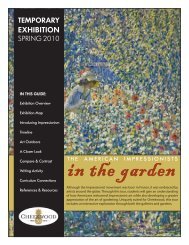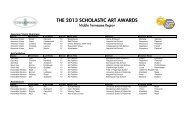Discover Cheekwood - Cheekwood Botanical Garden and Museum ...
Discover Cheekwood - Cheekwood Botanical Garden and Museum ...
Discover Cheekwood - Cheekwood Botanical Garden and Museum ...
- No tags were found...
Create successful ePaper yourself
Turn your PDF publications into a flip-book with our unique Google optimized e-Paper software.
A CLOSER LOOKportraitA portrait is a resemblance or image of a person that is created by an artist. The person (or people) who haveposed for the portrait is called the sitter. Often times there are clues in portraits that tell us more about theperson or their association. These clues are called symbols. Symbols represent something else by association.Portrait of William McCrackenGilbert Stuart (American, 1755-1828) | N.D., Oil on canvasFrom the beginning of his career, Stuart focused on painting portrait busts. This portrait is ofWilliam McCracken, a bishop from Dublin. It was painted to commemorate McCracken‟s part infounding the first Sunday School program in Belfast. The letter that he holds says, “Since thenwe can no longer have your presence as usual permit us to request a Memento to remind us ofhim who has been The Father of our Schools.”While painting the head <strong>and</strong> shoulder view, Stuart found that he could describe the sitter‟spersonality through facial features without the distraction of busy backdrops. After studyingunder many notable artists, he developed a unique style that departed from tradition with hisuse of color <strong>and</strong> soft line. As a result, his portraits achieved a likeness more genuine <strong>and</strong>accurate than those of his rival painters.did you know?Where have you seen a Gilbert Stuart portrait before? Stuart‟sportrait of George Washington was engraved on the one dollar bill.The Ephraim Hubbard Foster FamilyRalph E.W. Earl (American, 1785-1838) | 1825 | Oil on mattress tickingRalph E.W. Earl studied under his father, portrait painter Ralph Earl, <strong>and</strong> becameknown as “the king painter” for his numerous portraits of President AndrewJackson. He became so close to Jackson that he was buried in the cemetery ofJackson‟s Nashville home, the Hermitage.By the time Earl painted this portrait, Colonel Ephraim Hubbard Foster had alreadyestablished himself as private secretary to General Andrew Jackson, havingserved Jackson during the Creek War of 1813-1815 at the battles of Talledega, Enoctochopee, Emuefaw, <strong>and</strong> Topeka.In 1817 Foster married Jane Dickinson, the widow of the attorney for whom he apprenticed. Foster was admitted to thebar in 1820 <strong>and</strong> developed a thriving practice. He was known for his wit <strong>and</strong> temper.This portrait shows Foster at one of the high points in his life. He is about 35 years old <strong>and</strong> is surrounded by his wife<strong>and</strong> five children. The portrait shows the Fosters as a wealthy family in expensive clothing <strong>and</strong> elegant furnishings,unlike the usual accommodations in Nashville during 1825. Earl added personal touches to the painting, such as thepenny whistle <strong>and</strong> the extravagant hat that the young daughter is wearing. All members of the family are touching insome way <strong>and</strong> the baby in Jane‟s lap is sucking his fingers. The baby was born while the portrait was being completed,<strong>and</strong> was painted in later (as indicted by the way the child‟s contour follows the folds of the mother‟s dress).PORTRAIT6


